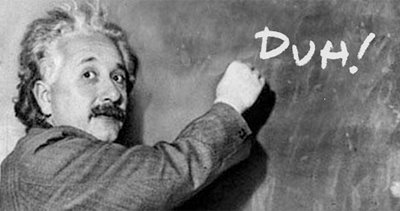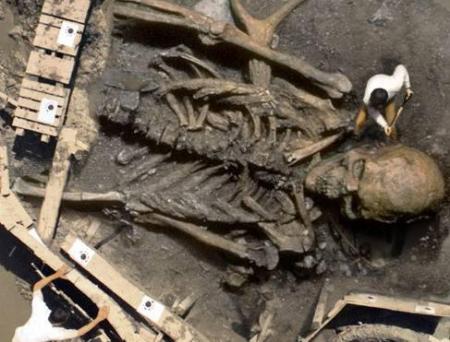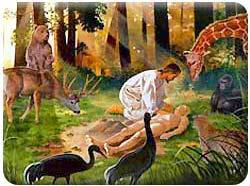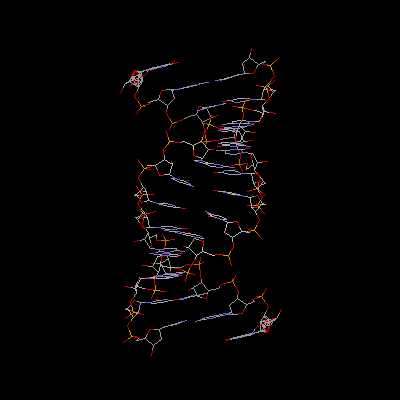“Evolution” mixes two things together, one real, one imaginary.
Variation is the real part. The types of bird beaks, the colors of moths, leg sizes, etc. are variation. Each type and length of beak a finch can have is already in the gene pool for finches. Creationists have always agreed that there is variation within species, but of course not ACROSS SPECIES which is evolutions problem.
But what evolutionists do not want you to know is that there are strict limits to variation that are never crossed. They want you to think that changes continue, merging gradually into new kinds of creatures. This is where the imaginary part of the theory of evolution comes in. It says that new information is added to the gene pool by mutation and natural selection to create frogs from fish, reptiles from frogs, and mammals from reptiles, to name a few.
Do these big changes really happen? Evolutionists tell us we cannot see evolution taking place because it happens too slowly. A human generation takes about 20 years from birth to parenthood. They say it took tens of thousands of generations to form man from a common ancestor with the ape, from populations of only hundreds or thousands. We do not have these problems with bacteria. A new generation of bacteria grows in a matter of hours.
There are more bacteria in the world than there are grains of sand on all of the beaches of the world (and many grains of sand are covered with bacteria). They exist in just about any environment: heat, cold, dry, wet, high pressure, low pressure, small groups, large colonies, isolated, much food, little food, much oxygen, no oxygen, in toxic chemicals, etc. There is much variation in bacteria. There are many mutations (in fact, evolutionists say that smaller organisms have a faster mutation rate than larger ones1).
But they never turn into anything else. They always remain bacteria. Fruit flies are much more complex than already complex single-cell bacteria. Scientists like to study them because a generation (from egg to adult) takes only 9 days. In the lab, fruit flies are studied under every conceivable condition.
There is much variation in fruit flies. There are many mutations. But they never turn into anything else. They always remain fruit flies. Many years of study of countless generations of bacteria and fruit flies all over the world shows that evolution is false and is not happening today.
This is how the imaginary part is supposed to happen: On rare occasions a mutation in DNA improves a creature’s ability to survive, so it is more likely to reproduce (natural selection).
That is evolution’s only tool for making new creatures. It might even work if it took just one gene to make and control one part.
But parts of living creatures are constructed of intricate components with connections that all need to be in place for the thing to work, controlled by many genes that have to act in the proper sequence.
Natural selection would not choose parts that did not have all their components existing, in place, connected, and regulated because the parts would not work. Thus all the right mutations (and none of the destructive ones) must happen at the same time by pure chance.
That is physically impossible. To illustrate just how impossible it is, imagine this: on the ground are all the materials needed to build a house (nails, boards, shingles, windows, etc.).
We tie a hammer to the wagging tail of a dog and let him wander about the work site for as long as you please, even millions of years. The swinging hammer on the dog is as likely to build a house as mutation-natural selection is to make a single new working part in an animal, let alone a new creature.
Only mutations in the reproductive (germ) cells of an animal or plant would be passed on. Mutations in the eye or skin of an animal would not matter. Mutations in DNA happen fairly often, but most are repaired or destroyed by mechanisms in animals and plants. All known mutations in animal and plant germ cells are neutral, harmful, or fatal. But evolutionists are eternally optimistic. They believe that many beneficial mutations were passed on to every species that ever existed, since that is the only way evolutionists think different species are made.
There are two versions of evolution. The first (neo-Darwinism) proposed that many tiny changes made new creatures. They could not find these tiny changes between one type of creature and another in the fossil record, so a few evolutionists proposed instead that change occurred by occasional leaps (punctuated equilibrium).
Each hypothetical beneficial mutation could only make a slight change. Any more than that would be so disruptive as to cause death. So punctuated equilibrium is not really one leap at a time.
It envisions a lot of slight changes over thousands of years, then nothing happens for millions of years. Evolutionists say with a straight face that no fossils have been found from a leap because thousands of years is too fast in the billions of years of “geologic time” to leave any.
On the other hand, without fossils there is no evidence that any leaps ever happened, and of course there is no evidence that leaps or gradual changes are happening today in any of the millions of species that still exist.
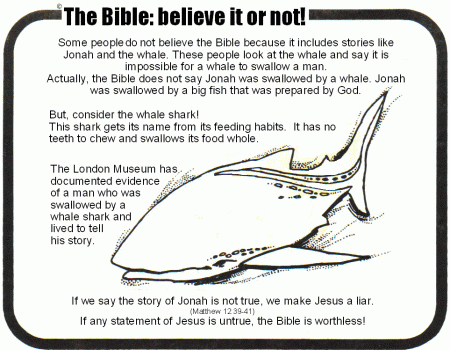 Evolution is all about constant change, whether gradual or in leaps. Consider a cloud in the sky: it is constantly changing shape due to natural forces.
Evolution is all about constant change, whether gradual or in leaps. Consider a cloud in the sky: it is constantly changing shape due to natural forces.
It might look like, say, a rabbit now, and a few minutes later appear to be, say, a horse. In between, the whole mass is shifting about. In a few more minutes it may look like a bird.
The problem for evolution is that we never see the shifting between shapes in the fossil record. All fossils are of complete animals and plants, not works in progress “under construction”. That is why we can give each distinct plant or animal a name.
If evolution’s continuous morphing were really going on, every fossil would show change underway throughout the creature, with parts in various stages of completion. For every successful change there should be many more that lead to nothing. The whole process is random trial and error, without direction.
So every plant and animal, living or fossil, should be covered inside and out with useless growths and have parts under construction. It is a grotesque image, and just what the theory of evolution really predicts.
Even Charles Darwin had a glimpse of the problem in his day. He wrote in his book The Origin of Species: “The number of intermediate varieties which have formerly existed on Earth must be truly enormous. Why then is not every geological formation and every stratum full of such intermediate links?
Geology assuredly does not reveal any such finely graduated organic chain; and this, perhaps, is the most obvious and gravest objection which can be urged against my theory.” The more fossils that are found, the better sense we have of what lived in the past. Since Darwin’s day, the number of fossils that have been collected has grown tremendously, so we now have a pretty accurate picture.
The gradual morphing of one type of creature to another that evolution predicts is nowhere to be found. There should have been millions of transitional creatures if evolution were true.
In the “tree of life” that evolutionists have dreamed up, gaps in the fossil record are especially huge between single-cell creatures, complex invertebrates (such as snails, jellyfish, trilobites, clams, and sponges), and what evolutionists claim were the first vertebrates, fish. In fact, there are no fossil ancestors at all for complex invertebrates or fish. That alone is fatal to the theory of evolution. The fossil record shows that evolution is wrong and never happened.
The platypus has a duck-like bill, swims with webbed feet, and lays eggs. Yet nobody calls it a transitional creature between mammals and ducks.
Archaeopteryx has long been held up as the great example of a transitional creature, appearing to be part dinosaur and part bird. However, it is a fully formed, complete animal with no half-finished components or useless growths. That is also the case for the other birds in the evolutionary tree. Evolutionists just placed some of the many living and extinct species next to each other to make the bird series.
The same is true for the famous horse series. Fossils of each type of supposed ancestor are of complete animals. They are not full of failed growths and there are no parts under construction. There are many more differences between each type of animal than their size and the number of toes. Every change in structure, function, and process, between Hyracotherium (formerly Eohippus) and the horse would have had to have developed through random trial-and-error if evolution were true.
The fossils have not caught any of these changes in the midst of being created, even though they should have occurred over long periods of time. Evolutionists just placed living and extinct species next to each other to make the horse series.
When researchers began “reading” the amino acids in proteins in the 1960′s, evolutionists expected that proteins such as hemoglobin or cytochrome C, common to many types of creatures, would be more alike for creatures close to each other on the evolutionist’s “tree of life”, and more unlike for creatures farther apart on the “tree of life”.
Instead, this comparative biochemistry found that the protein sequences were just as different between creatures near on the tree as between those far apart, using percent of sequence differences. There is lots of variation in these proteins, but no evolutionary progression.
 Another old evolution myth still popular is the notion that things that look like gill slits, tails, etc. in developing human embryos show the embryo repeating all the stages of human evolution.
Another old evolution myth still popular is the notion that things that look like gill slits, tails, etc. in developing human embryos show the embryo repeating all the stages of human evolution.
In 1866, Ernst Haeckel proposed his “biogenitic law” (not to be confused with the law of biogenesis that says life only comes from life). His idea was that growing vertebrate embryos went through all the forms of their supposed evolutionary ancestors (“ontogeny recapitulates phylogeny”). He published drawings comparing growing embryos of a number of animals such as the pig, cat, salamander, etc.to growing human embryos.
The similarities that he said he found helped persuade people to believe the theory of evolution. Scientists eventually discovered enough about embryology to quietly discard the “biogenetic law”, but it was not until a careful photographic study of growing vertebrate embryos was conducted in 1997 that Haeckel’s deceit was fully revealed.
They found that his drawings were so far from reality that they could not have been done from the actual embryos.4 He must have faked them.
Evolution violates two laws of science. The Second Law of Thermodynamics says that things fall apart over time, they do not get more organized, unless there is already a mechanism in place to build things up.
But this very same Law prevents such a mechanism from assembling by itself. The Law of Biogenesis was established by Louis Pasteur three years after Darwin’s book was published, and simply says that life only comes from life. Living cells divide to make new cells, and fertilized eggs and seeds develop into animals and plants, but raw chemicals never fall together and life appears.
Evolutionists often call certain chemicals “the building blocks of life”, giving people the false impression that you just stack the building blocks together and you get life. No one has ever done that, including the famous 1953 Miller/Urey experiment where all they got were clumps of amino acids.
Many people mistakenly think scientists have made life from chemicals in the lab, but they have not (though many have tried very hard). If one were to succeed, you would know about it. He would get every science award there is, be all over the news, and have movies, books, buildings, statues, and schools dedicated to him, so desperate are evolutionists on this matter. For something to be a law of science, it can never be found to have been violated, even once, over thousands of trials. No exceptions. A theory that violates two laws of science is in big trouble.
When confronted with the Second Law of Thermodynamics, evolutionists usually use two tricks to try to escape. The first is to state that “it only applies to closed systems, and biological creatures are open systems, so it doesn’t affect evolution.” Since most people know nothing about open or closed systems, the trick works. The fact is that the Second Law applies to all systems, open or closed, and to all actions and chemical reactions, from molecules to galaxies. The words “except for…” are not in this universal law. “Open system” means energy is free to flow through from the outside.
For example, you eat food (which comes from outside yourself) and your body survives. Evolutionists believe that all you need is an open system with sufficient energy flowing into it for evolution to succeed. If that were so, you could just stand right behind a jet engine as the aircraft prepares for takeoff, absorb that blast of energy, and evolve to a higher life form. In reality, of course, you would be incinerated because absorbing energy without a mechanism to convert it to a useful form is destructive or useless.
The mechanism must be very specific. Sticking food in your ear will not work; it must go into your mouth and through the digestive system. And the mechanism must be in place and functioning first, before energy is added or the energy is wasted.
The “open system” ploy is just an attempt to avoid dealing with the Second Law because the Law prohibits any biological mechanism from falling together by pure chance, without assistance or plan, using only the properties of matter.
The second trick is to say that “when you freeze water, the disordered molecules become beautifully ordered ice crystals or snowflakes. If water can bypass the Second Law and organize its molecules by a natural process, why not the chemicals of life?” At room temperature, water molecules are bouncing off each other and you have water.
When you take away heat and they freeze, water molecules stick to each other with weak molecular bonds, forming ice crystals and snowflakes because of the shape of the H2O molecule. The same thing happens if you put a bunch of weak magnets in a jar and shake it. The magnets bounce around. When you stop, the magnets stick together. They are at a lower energy level.
There is order, yet no complexity – just a simple repetitive structure that does not do anything. The Second Law is not bypassed or violated. But guess what. Amino acid molecules that form proteins, and nucleotide molecules that form DNA and RNA resist combining at any temperature.
To combine, they need the help of mechanisms in a living cell or a biochemist in an organic chemistry laboratory. It means that nothing happens in the primeval soup, the pond of chemicals where evolutionists believe life began. DNA and RNA dissolve in water5, so there could not even be water in the primeval soup . DNA is made of only right-handed versions of nucleotides, while proteins are made of only left-handed versions of amino acids.
. DNA is made of only right-handed versions of nucleotides, while proteins are made of only left-handed versions of amino acids.
Yet any random chemical reaction that produced nucleotides or amino acids would make an equal mix of left and right-handed versions of each. Even if the thousands of nucleotides or amino acids needed to form individual DNA or protein molecules were able to combine from this mix, they would be a jumble of left and right-handed versions that could not function at all. Ilya Prigogene coauthored a paper in 1972 that says in an open “system there exists a possibility for formation of ordered, low-entropy structures at sufficiently low temperatures.
This ordering principle is responsible for the appearance of ordered structures such as crystals… Unfortunately this principle cannot explain the formation of biological structures.”3 Prigogene won the Nobel Prize in Chemistry in 1977 for research in dissipative structures, such as tornados, for contributions to nonequilibrium thermodynamics, and for bridging the gap between biology and other sciences. Evolutionists wrongly claim he won for showing how thermodynamics could explain the formation of organized systems, from fluctuations in chaos, that lead to the origin of life. They thought he was their hero. Thirty years later, nothing has come of it.
There is no escape from the Second Law of Thermodynamics. It prohibits the spontaneous origin of life and the progression from microbes to man.
Even a single cell is not simple. In Darwin’s day researchers looked at cells under the microscope and saw little balloons filled with goo they called protoplasm, so they thought cells were simple forms of life. Almost 150 years later we know that there are many types of cells, and each cell is a little city at work.
The smallest known genome (Mycoplasma genitalium) has 482 genes.2 The minimum possible for an organism to survive is probably 200 to 300 genes. Most bacteria have 1000 to 4000 genes. A popular textbook on the cell (Molecular Biology of THE CELL, 4th edition, 2002, Alberts, Johnson, Lewis, Raff, Roberts, Walter; Garland Science, NY, NY) is almost 1500 pages long and weighs 7 pounds. Everything about the cell is stunningly complex. Plants and animals are made of many millions of cells.
There are only two possibilities. Either every part of every living thing arose by random chance, or an intelligence designed them. In spite of the overwhelming evidence that the theory of evolution is dead wrong, many are not ready to throw in the towel. They desperately hope that some natural process will be found that causes things to fall together into organized complexity.
These are people of great faith. And they are so afraid of connecting God with science that, like the Japanese Army of World War II, they would rather die than surrender. Unfortunately, the staunchest defenders sit in places of esteem and authority as professors, scientists, and editors, and have the full faith of the news media. The public is naturally in awe of their prestige. But once the facts are spelled out it becomes obvious that the theory of evolution is long overdue for the trash can, and to perpetuate it is a fraud. Perhaps it made sense for what was known when The Origin of Species was published in 1859, but not today.
Darwin is liked by evolutionists because he liberated science from the straitjacket of observation and opened the door to storytellers. This gave professional evolutionists job security so they can wander through biology labs as if they belong there.
From David Coppedge
Speaking of Science, Creation Matters, May/June 2003
COME ON SKEPTICS..BRING IT ON!
- God and Science: Divine Causation and the Laws of Nature
- Unintelligent Design: This the single most idiotic excuse for Atheism I’ve ever endured!
- Great Responce – Re: Unintelligent Design
- ARE YOU READY to Die for Jesus? Powerful
- What is Proof?
- Alistar McGrath — Atheist turned Christian
- Would Someone Die For A Lie? – Lee Strobel
- 5 Reasons God Exists
- For the FAKE Church…Listen Carefully!
- Where do Evil thoughts come from? Ravi Zacharias explains
- The Bible Can Be Trusted – Lee Strobel
- Mathematical and Logical Proof for the Bible
- Dr Kent Hovind debates Dr James Paulson
- Jesus Heals…..period!
- Reliability of Christs Resurrection – Lee Strobel
- Evidence Jesus Was God – Lee Strobel
- Could the Universe just Pop into Being?
- Ravi Zacharias &Postures of the Mind, Affections of the Heart!
- How Many People Saw Jesus Alive? – Lee Strobel
- ABC Nightline Faceoff: Ray Comfort Proves that God Exists
- That’s My King! Who is Jesus to you?
- Evidence for God from DNA_Lee Stobel
- Evidence against Darwinian Evolution_Lee Strobel
- Evidence for God from Cosmology_Lee Strobel
- Famous Athiest Antony Flew Changes Mind, Believes in God
- Who was Jesus……Really?
- What would happen? Think about this!
- Evidence for God from Biochemistry_Lee Strobel


